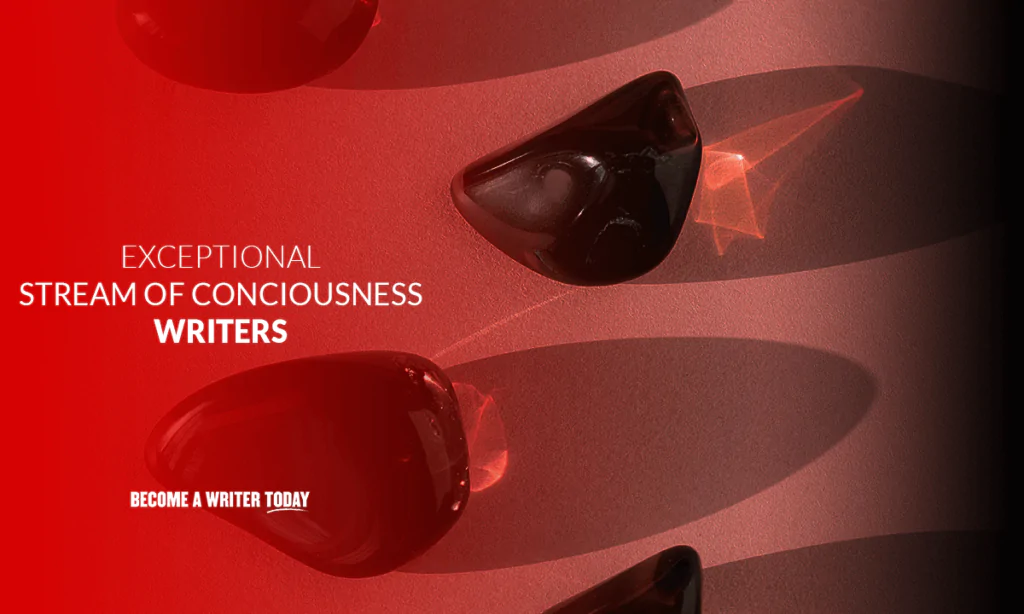Looking to see what happens inside a character’s thoughts? Check out these fifteen stream of consciousness writers.
Stream of consciousness writers forgo dialogue and traditional prose, writing instead entirely from the point of view of their main character, telling that character’s inner thoughts and personal dialogue. This literary device gives the writing a unique feel and provides the reader with insight into what the character is feeling and thinking throughout the story’s events.
The phrase stream of consciousness first hit the literary criticism world when critic May Sinclair borrowed the phrase from a popular psychology book and applied it to the work of novelist Dorothy Richardson. This writing style became very popular in the early to mid-20th century, though it still appears in modern novels.
As you discover stream of consciousness writers, choose carefully. This writing style takes skill to master. Nevertheless, here are fifteen who have done it well.
Stream of Consciousness Writers to Discover for Yourself

Stream of consciousness writing can be challenging to read. If you are ready to indulge in seeing the inner thoughts of a character, here are some authors who are known for using this literary device masterfully.

1. Virginia Woolf
Virginia Woolf’s famous novel Mrs. Dalloway follows a middle-aged society woman throughout her day, following the main character’s thoughts in interior monologue. She is considered the pioneer of the stream-of-consciousness narrative technique and also wrote To the Lighthouse and A Room of One’s Own. Her works are highly poetic and were considered very experimental at the time.
- Woolf, Virginia (Author)
- English (Publication Language)
- 108 Pages - 01/01/2021 (Publication Date) - Independently published (Publisher)
2. James Joyce
Irish novelist, poet, and short-story writer James Joyce is called one of the most influential 20th-century writers. His novel Ulysses is a perfect example of stream-of-consciousness writing, following the encounters of Leopold Bloom as he goes about a typical day in Dublin. A Portrait of the Artist as a Young Man is another famous work that many believe is a bit of a self-portrait of Joyce’s own thoughts.
We have many more articles on famous poets from around the globe. Why not check out our list of the best famous Irish poets? Or use the search bar at the top right of the page to search for the best authors in a country or region you are interested in.
- James Joyce (Author)
- English (Publication Language)
- 736 Pages - 01/15/2010 (Publication Date) - Wordsworth Editions Ltd (Publisher)
3. William Faulkner
Perhaps one of the most significant American writers, William Faulkner, wrote about the Old South and was awarded the Nobel Prize in Literature in 1949 for his work. His fourth novel, The Sound and the Fury, depicts the stream of consciousness in one of its four sections, where Quentin Compson, one of the main characters, details his thoughts before committing suicide.
The unconventional narrative style of the rest of the book meant critics rejected it at first, but today it’s considered a literary masterpiece.
- Used Book in Good Condition
- Faulkner, William (Author)
- English (Publication Language)
- 326 Pages - 10/01/1990 (Publication Date) - Vintage (Publisher)
4. William James
Most famous for his 1,200-page work The Principles of Psychology, psychologist William James explores what makes up the stream of thought in the human being. He is credited with coining the term stream of consciousness, and though he did not write fiction works in this field, he did give the English language a new literary term.
- James, William (Author)
- English (Publication Language)
- 574 Pages - 02/18/2017 (Publication Date) - CreateSpace Independent Publishing Platform (Publisher)
5. Dorothy Richardson
Dorothy Richardson was a middle-class woman from a suburb of Oxford. She began her writing career with essays and journalistic pieces for magazines, and her work, Pilgrimage, Richardson shows the internal monologue of her character. The work spans three novels and follows a central character, Miriam Henderson, modeled on the author’s own life story.
- Richardson, Dorothy (Author)
- English (Publication Language)
- 152 Pages - 12/29/2015 (Publication Date) - CreateSpace Independent Publishing Platform (Publisher)
6. Henry James
American and British author Henry James helped create the transition between realism and modernism with his writing around the turn of the 20th century. He used the stream-of-consciousness technique in portions of The Portrait of a Lady. Henry James was the brother of William James, who coined the term.
- James, Henry (Author)
- English (Publication Language)
- 458 Pages - 09/13/2021 (Publication Date) - Digireads.com (Publisher)
7. Marcel Proust
Marcel Proust was ahead of his time with the use of stream of consciousness, which shows up in his novel series In Search of Lost Time, published between 1913 and 1927. Though not a perfect example, this novel shows the internal thoughts of characters regularly and sets the stage for what would become a more common literary technique in the future.
- Used Book in Good Condition
- Proust, Marcel (Author)
- English (Publication Language)
- 4211 Pages - 06/03/2003 (Publication Date) - Modern Library (Publisher)
8. Jack Kerouac
In his 1957 novel On the Road, Jack Kerouac follows Sal Paradise as he travels across the United States. It follows one single train of thought throughout the piece, and Kerouac actually typed the piece using one continuous reel of paper. Time Magazine named this one of the 100 best English language novels from 1923 to 2005.
- Jack Kerouac (Author)
- English (Publication Language)
- 293 Pages - 06/01/1999 (Publication Date) - Penguin Classics (Publisher)
9. Leo Tolstoy
Famous Russian author Leo Tolstoy used stream of consciousness in Anna Karenina, an 1878 novel that explores Imperial Russian society and has been the subject of theater, film, television, and, even ballet performances. Though the entire novel is not an example of a literary device, instead, it employs it several times. Tolstoy is considered one of the top writers in Russian history, and he is also the author of the famous War and Peace.
- Tolstoy, Leo (Author)
- English (Publication Language)
- 590 Pages - 11/08/2020 (Publication Date) - Independently published (Publisher)
10. T.S. Eliot
The Love Song of J. Alfred Prufrock is a poem by T.S. Eliot that uses a stream of consciousness to tell the narrator’s thoughts. By employing the point of view of Prufrock, Eliot is able to show just how disjointed and unclear his thought process is. The reader feels that the poem is slightly confusing, but that is because the way the human mind jumps from thought to thought is also disjointed.
- Hardcover Book
- T. S. Eliot (Author)
- English (Publication Language)
- 67 Pages - 12/06/2002 (Publication Date) - Amereon Ltd (Publisher)
11. Samuel Beckett
In his trilogy that includes Molloy, Malone Dies, and The Unnamable, Samuel Beckett employs stream-of-consciousness writing. Unfortunately, the plots of these stories are fairly weak because the writer’s primary goal is to keep the narration going to show the character’s thoughts
- Samuel Beckett (Author)
- English (Publication Language)
- 416 Pages - 06/16/2009 (Publication Date) - Grove Press (Publisher)
12. Sylvia Plath
Sylvia Plath is a poet and novelist who used the technique in her writing. Her novel, The Bell Jar, tells of a young woman’s journey with depression from her own point of view. Stream of consciousness writing makes this piece particularly powerful, as the reader gets a glimpse into the disordered thinking that comes with mental illnesses of depression and anxiety.
- Great product!
- Plath, Sylvia (Author)
- English (Publication Language)
- 244 Pages - 08/02/2005 (Publication Date) - Harper Perennial Modern Classics (Publisher)
13. Jose Saramago
Jose Saramago wrote in the stream-of-consciousness style quite frequently. In addition, he often dropped the punctuation from his dialogues to create an endless flow of ideas, and this style mirrors how thoughts flow through an individual’s brain. His work Blindness is a clear example of using this writing style, and he won the Nobel Prize in 1998.
- Hardcover Book
- Saramago, Jose (Author)
- English (Publication Language)
- 304 Pages - 09/01/1998 (Publication Date) - Houghton Mifflin Harcourt (Publisher)
14. Fyodor Dostoyevsky
While he may be best known for Crime and Punishment, Fyodor Dostoyevsky employed the stream-of-consciousness style in a novella he published in 1864 entitled Notes from Underground. Both works are considered classics of Russian literature. In Notes from Underground, the main character, Underground Man, writes in a continuous train of thought using commas and brackets, but not sentences.
15. Toni Morrison
Finally, Toni Morrison wrote often on slavery, and Beloved is one of her novels that uses a stream of consciousness. While the technique is not used in the entire novel, she uses it expertly in one of the last chapters as she intermingles the thoughts of three of the characters into one tangled mess. The modern African-American novelist often wrote of the difficulties faced by black Americans.
If you want to learn how to begin writing stream of consciousness then check out our guide to exploring stream of consciousness is here to help! Or if you want to read the best books from the best authors, you can search for them on our website using our search bar.
- towering achievement
- Toni Morrison (Author)
- English (Publication Language)
- 321 Pages - 06/08/2004 (Publication Date) - Vintage (Publisher)
